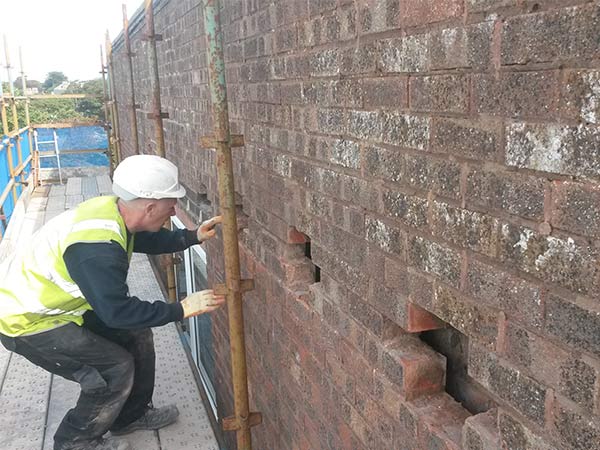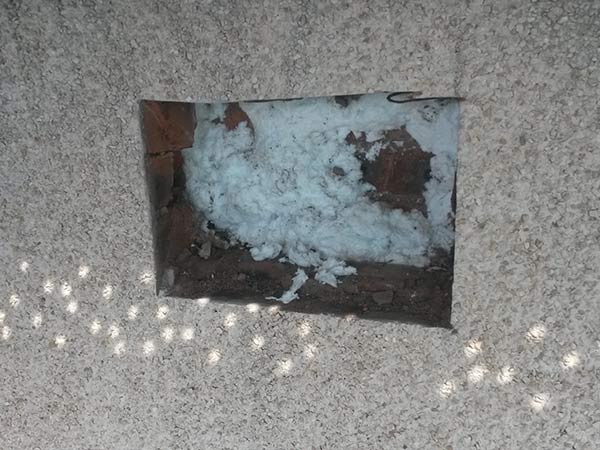Cavity Wall Insulation Removal

Cavity wall insulation can become affected by moisture and result in damp issues becoming prevalent within your property. If you are concerned that your cavity wall insulation is causing a damp issue in your property this page will provide answers to your questions. Get a better understanding of what cavity wall insulation is and why sometimes cavity wall insulation removal is the only way to solve a damp problem in your property.
Tired of reading? Listen to this article!
Why Should You Remove Cavity Wall Insulation?
When installed correctly and with the right material, cavity wall insulation in a house which is in good condition externally will ensure your property remains safe, energy efficient and warm.
Unfortunately, cavity wall insulation can result in penetrating damp, condensation and mould if the following occurs:
- The cavity was not appropriately cleared prior to the insulation installation
- Your property’s location is within a high wind and rain exposure area causing penetrating damp
- Your property suffers from damage to external walls such as cracks within the render, pointing or brickwork.
- Your property’s structure is not appropriate for cavity insulation
- It has not been installed correctly
- The cavity is suffering from blockages as a result of building works
- The insulation is aging and suffering from slumping.
If cavity wall insulation becomes wet, it will soak up the water moving it across the cavity and potentially affect the wall surface in your home. Insulation becoming wet can prove immensely difficult to rectify and dry out. This can result in damp walls in your property, which is likely to result in increased energy costs for your property. Furthermore, your property is likely to be considerably colder and suffer from damp smells and mould growth.
All of the above-mentioned property issues can have negative effects on both the property and the resident themselves. The property can have their wall ties rusting which can lessen the overall structural integrity of the property’s external walls. With regards to the resident, the quality of air within the property can become negatively impacted by the presence of damp and mould.
These problems may take several years to develop before you begin to notice issues within your property. Damp may be damaging your walls long before the issues begin to present themselves. It’s likely that your energy costs will also be rising as a result of your heating being forced to work harder in order to maintain an adequate temperature.
How Does Cavity Insulation Work?
The most commonly used technique to install cavity wall insulation is injecting special insulation material into the cavity between the two walls. Companies who provide this service usually start this process by drilling holes externally in your walls which are around 22mm in diameter which are spaced around 1 metre apart. A special material is then injected into the wall before sealing over the holes with cement or render. The most commonly material used when installing insulation has been mineral wool and polystyrene beads although there are instances when polyurethane foam has been utilised.
This can result in improvement of the insulation of the wall which prevents warm air from escaping from the property into the cavity and can stop cold air from gaining access into the property.
Can Cavity Wall Insulation Cause Damp?
Damp issues tend to be the most common reason for consumers contacting us asking for cavity wall insulation removal.
It tends to be a result of a number of key factors:
- The property’s external brickwork allowing penetrating damp
- Breakdown of external render
- Defective roof coverings or gutters
- Substantial exposure to poor weather causing penetrating damp through the external walls
- Condensation
- A combination of the above

There is known to be an increased risk of rain penetration into your property if a cavity happens to be filled with insulation. Rain which penetrates the outer wall can easily bridge the cavity as a result of the insulation material which can transfer moisture to the internal walls which can easily result in damp affecting your living space.
The key symptoms to look out for in your property are:
- Built up of mould and condensation on external walls
- Decorative surfaces becoming stained and flaking paint or detached wallpaper
- A damp smell being prevalent in your property
- Cold spots on external walls
These symptoms could point towards an inadequate installation or failing cavity wall insulation.
Cavity Wall Insulation Removal
The way which the existing insulation material should be removed depends on the type of insulation material which has been installed. The process tends to begin with the removal of bricks at the bottom of the wall to create pockets. Holes will then be drilled in the external wall in strategic positions. Using a cavity wall extraction system, the old insulation material will be sucked out of the wall. The remnants will then be collected in large bags. Our specialists will utilise a borescope to fully inspect the cavity throughout the removal process to ensure that the entirety of the damaged insulation has been removed. Once our specialists are satisfied that the cavity wall extraction process has been completed, the wall will be repaired. A clean the work area surrounding the property will then be completed to make sure that debris is removed.
What You Need To Do Now?
Having your property undergo a damp survey from Richardson & Starling’s specialists is the first step to having your properties damp issues being resolved. Failing cavity wall insulation and external wall defects can result in penetrating damp, condensation and mould and it is vital that you utilise specialists who can correct these issues if they arise. Our PCA certified specialists can remove the damaged cavity wall insulation and any other action that is required to rectifying the damp issues within your property. Misdiagnosing your damp problem can result in the unnecessary waste of your maintenance budget. Property owners should look for a rational approach to the diagnosis and treatment of their damp problems, and this is exactly what Richardson & Starling’s damp specialists provide.Our cavity wall surveyor can survey your property and provide specialist advice on approaching cavity wall insulation removal.
